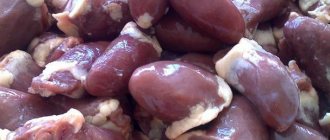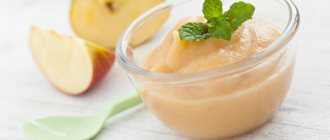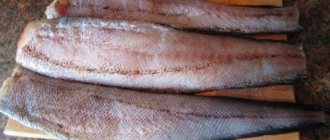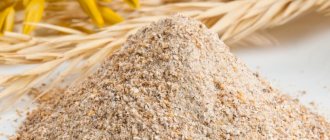Useful properties of crab
Freshwater and sea crabs differ somewhat in their set of microelements. It is believed that sea meat is more valuable for dietary nutrition, as it can be considered a source of iodine. In dry figures, the calorie content of fresh crab meat is 73 kcal. After boiling (regular boiling in water or steaming or grilling without additional high-calorie fat), crab meat provides the body with 91 kcal. The product is considered dietary. Obviously serves as a source of protein. Carbohydrates in crab meat range from 1 to 3 g, and fat is also minimal.
The beneficial properties of crab meat are due to its chemical composition. Proteins are a source of essential amino acids, “building materials” for the cells of our body. Protein deficiency is a very harmful condition for humans. We cannot synthesize some amino acids on our own, which affects both the state of the immune system and the speed of metabolic processes. Many scientists link constant hunger, snacking and obesity to a protein-deficient diet. An adult needs 1 to 2 g of protein per kilogram of weight daily. Crab meat is considered a good bioavailable source of this macronutrient. Unlike, for example, plant proteins, it is well absorbed.
The percentage of essential amino acids to regular amino acids in this meat is very high, and distinguishes crabs from most fish and crustaceans. If plant proteins predominate in the diet, it makes sense to include seafood in it too, in order to satisfy the body’s need for “building material”.
The meat of most edible crabs contains carbohydrates - this is ordinary glycogen. Due to the sweet taste and the constant discussion of the glycemic index of food and its effect on body fat, many people do not eat crabs. Meanwhile, 3 grams of carbs in an easily accessible form, as long as you get most of your calories from protein, won't kill you. Proponents of the glycemic index theory should know that it decreases in foods if protein and fiber are added to them. By this logic, those losing weight should eat crab meat with vegetables, and everything will be fine.
Classical dietetics, on the contrary, recommends crabs as one of the low-calorie foods. In addition to protein, meat contains B vitamins, as well as antioxidants - vitamins A and E, iodine, iron, magnesium and sulfur. And this already contributes not only to satiety, but also to improved health. Sources on nutrition mention that crab meat is useful for metabolic disorders, disruptions in the nervous system, decreased levels of thyroid hormone secretion, and chronic fatigue syndrome.
Crab meat promotes skin renewal and rejuvenation due to vitamins A and E, and is useful for people with visual impairments. It is believed that it can also serve as an additional source of vitamin E for those who strive for a speedy recovery after operations and other interventions that violate the integrity of the skin.
Crab meat is recommended to be included in the diet of patients with cardiovascular diseases. The minerals in the product, as well as vitamins A and E, help restore the heart muscle after exercise. Crabs are called one of the food products that “fight” cholesterol, or more precisely, its deposits on the walls of blood vessels.
Crab meat is also recommended for consumption when metabolism is slow due to hypothyroidism, as well as for those who have problems due to iron deficiency.
The benefits and harms of crab meat – Healthy Harmful
Crab meat is a seafood product obtained from the abdomen, claws and legs of a crab. The benefits and harms of crab meat are often underestimated, so it is important to know how to choose and prepare the product so as not to spoil its beneficial properties and not harm yourself.
What is crab meat
The natural product is extracted from the abdomen, claws and limbs of the crab and is a delicacy, easily absorbed by the body and has great health benefits.
It is important to distinguish meat from surimi sticks, which consist of finely chopped and pressed fish or even soy. They do not have any special beneficial properties, and additives of unnatural origin can even harm the body.
Crab meat is obtained from sea and freshwater crabs. Marine species are more tasty, contain more nutrients and are of greater benefit to humans.
Chemical composition and calorie content of crab meat
Crab meat contains a very high amount of protein and little fat and carbohydrates, nutritional value per 100 g:
- proteins – 18 g,
- fats – 1.8 g,
- carbohydrates – 0.4 g.
Seafood contains vitamins B1, B9, B6, B2, B5, B3, A and macro- and microelements: potassium, selenium, magnesium, calcium, zinc, phosphorus, sodium, iodine, iron, manganese, copper.
Benefits of crab meat
A large number of beneficial properties of crab meat are due to its rich chemical composition.
Crab meat is a dietary high-protein product, it is perfect for athletes and will be useful for losing weight.
Vitamin B3, contained in meat, stabilizes cholesterol levels and normalizes metabolism. Vitamin B5 has a positive effect on brain activity and helps the body absorb other beneficial substances. Vitamin B6 promotes normal functioning of the nervous system and slows down skin aging. Vitamin A and taurine support good vision and are powerful antioxidants.
Zinc is useful because it ensures normal brain function and bone health. Potassium has a positive effect on the functioning of the musculoskeletal system, brain and circulatory system. Iodine is good for the thyroid gland. Other minerals in the composition maintain water-salt balance in the body and are beneficial for digestion.
Another property of crab meat is its benefits for men: being an aphrodisiac, seafood increases potency and is an excellent prevention of male diseases.
How to cut and clean crab
All limbs of the boiled specimen are removed. Using special scissors, cut the shell on the abdomen along a natural line, as shown in the picture. The internal organs (intestines and gills) are removed and discarded, and the meat should be removed.
The claws and paws of the animal are split with the handle of a heavy knife, tongs or a rolling pin, and the meat is removed from them.
Important! You should not apply great force when splitting; the structure of the product tends to deteriorate from strong mechanical stress.
You can remove the meat from the legs with a small fork.
If you need to cut an individual of a large species (Kamchatka, for example), you will have to use kitchen scissors or pruners. A longitudinal incision is made on each leg, with each phalanx cut separately. To do this, it is better to separate the phalanges by spinning them in different directions.
After this, the meat is removed from the phalanges of the legs and the chitinous strips are removed using tweezers.
How to cook and boil crab
Carcasses are cooked whole or cut up; in the latter case, they reach condition faster.
Comment! After cooking, a whole carcass should be rinsed in broth to prevent marine debris from getting into the meat.
The amount of water is calculated as follows: 2.5 liters per 500 g of product. After boiling, it is better not to add water and calculate its amount in advance.
Sea water is ideal for cooking. If it is not possible to use such water, a good substitute would be fresh water with sea salt instead of regular salt.
Attention! Before cooking, it is best to place a live crab under running cold water or for a few minutes in a container with cool water, this will cause it to go into suspended animation.
You need to add salt and spices to the water (you can taste lemon juice, pepper, garlic, cloves, bay leaves) after boiling. Then you need to wait for the next boil and only then throw the carcass into the pan.
Depending on the size of the crab, cooking lasts 15-40 minutes.
- Crabs weighing up to 1.5 kg are boiled for 20-25 minutes.
- Weight more than 1.5 kg is boiled for 30-40 minutes.
Readiness is indicated by the red color of the shell and a strong characteristic aroma.
Important! Undercooking crab meat can bring no benefit, but great harm in the form of severe poisoning; overexposure to heat will make the structure of the meat rubbery.
Finished carcasses should be cooled by placing them on their back, this will preserve their juiciness and taste.
The carcass can also be cooked in a steamer, pressure cooker, slow cooker or microwave. There is also a method for steaming crab using a pan and colander. The benefit of this method is that when used, seafood quickly reaches a state of readiness and has high taste properties.
You need to pour water into the pan to the level where it barely touches the colander placed on it. The carcasses are placed in a colander and spices are added to the water. Place a colander on a saucepan and bring the water to a boil. The seafood is cooked until done.
When cooking in the microwave, the carcass must be wrapped in a wet towel and squeezed several times so that the surface of the crab is well moistened and steam is released during cooking.
Before putting food in the microwave, each part of it should be wrapped in plastic. This is necessary to prevent explosion, which often happens with a whole crab carcass when heated without water. Microwave is turned on for 2-3 minutes.
If after finishing its work you do not feel a pronounced aroma, you need to repeat the process.
What can you cook from crab meat?
You can prepare a lot of dishes from crab meat: the famous salad, sandwiches with crab paste, rolls, soup, phalanges of crab in a wok, tartlets and bruschetta with crab meat.
Harm of crab meat and contraindications
Crab meat has only one contraindication: severe individual intolerance.
How to select and store crab meat
Crabs can be purchased frozen, live, chilled or cooked. Of the first three options, the most optimal is the purchase of a live marine or freshwater inhabitant.
Among live crabs, you should choose young and active ones, and they should not be small. Young animals are easily identified by their dense shell. It is better to give preference to males; they differ from females by having a shorter tail that is curved under the abdomen.
There should be no damage to the body of the individual. They collect harmful bacteria that can be harmful to humans. In addition, the meat of such an animal will be less tasty.
Important! The pronounced “fishy” smell of the animal indicates long and possibly improper storage of the product.
If the individual is large and active, but the shell is not very strong, it is also suitable for cooking. The animal could have been caught while changing its shell; this would not cause harm and would not affect the taste of the finished meat.
Attention! The presence of stains and plaque on the shell is a reason to refuse the purchase.
Shallow and deep sea crabs have no difference in price and taste.
When frozen, crabs can be stored for up to a year. Live specimens are stored in the refrigerator in the vegetable compartment. It is better not to delay the preparation time and do it no later than a few hours after purchase.
Crab meat - benefits, harm, chemical composition, crab meat during breastfeeding
Crab meat, a product that has nothing in common with the well-known crab sticks, is a delicacy and one of the healthiest seafoods.
The meat is obtained from the claws, belly and limbs of the crab and is very tender and tasty..
In addition, it is easily absorbed by humans, enriching their body with essential amino acids, proteins and other biologically active substances. Crabs are not only nutritious, but also help promote health.
Composition and calorie content
The main components of crab meat are 6 g of protein, 1 g of fat and 10 g of carbohydrates per 100 grams of pure product. Its calorie content is only 73 kcal, which allows it to be used as food and as dietary meat.
The composition is supplemented by vitamins, mainly belonging to group B:
- nicotinic acid and niacin;
- riboflavin;
- folic acid;
- vitamin B12;
- thiamine;
- pyridoxine.
In addition, crab meat contains a lot of vitamin A, which is good for vision. The product also contains various minerals:
Particularly useful is taurine, a sulfonic acid contained in crab meat, a product of the metabolization of the amino acid cysteine . It is a substance similar to amino acids, although it does not contain a carboxyl group; In the body, it primarily plays the role of a neurotransmitter, improving brain activity.
Beneficial features
The benefits of crab meat are its dietary value and high protein content. Because of these properties, the product becomes an indispensable part of the diet of athletes and people involved in fitness to maintain slimness and beauty . It is quite possible to eat crabs when trying to lose weight, as it fully replenishes energy without being stored in the form of fat.
The greatest benefit to the body comes from taurine, which not only improves brain function, but also spreads throughout all tissues of the body, normalizing metabolism and strengthening the walls of blood vessels.
Because of this, blood flow improves and muscles become toned.
Due to these properties, taurine is often used in the form of dietary supplements, and is also included in energy drinks along with caffeine, often being even more effective than the latter.
Like other animal-based seafood, crab meat is rich in Omega-3 and Omega-6 unsaturated fatty acids. These substances improve the composition of the blood, clearing it of harmful cholesterol, and prevent the development of various pathologies of the cardiovascular system.
The high content of almost all vitamins included in group B determines the positive effect of crab meat on the digestive and nervous systems.
The benefit for the gastrointestinal tract also lies in the fact that the proteins that make up crab have a special structure, which makes them twice as easy for the intestines to digest than the meat of land animals.
Source: https://nadezhda-kaluga.ru/voda-i-napitki/polza-i-vred-krabovogo-myasa.html
Kamchatka crab
Kamchatka crab meat is the “sweetest”, it contains up to 3 g of glycogen per 100 g. Otherwise, its beneficial properties completely copy everything said for other crustaceans.
Kamchatka crabs are used not only for preparing canned food and frozen products. Their shells are a valuable source of chitosan.
Today there are many offers of dietary supplements with chitosan on the market; we are recommended to purchase them to “block fats.” Meanwhile, scientific research has proven the ineffectiveness of this approach. Chitosan from crabs or krill is not able to “block” branched lipid molecules in the human digestive tract. Therefore, “crab” tablets should not be considered an analogue of Xenical. Their consumers are destined to gain weight anyway if they overeat, despite the remedy.
Dietary supplements with chitosan are useful only as an additional source of fiber, and a good way to somewhat speed up the process of evacuation of the food bolus from the intestines. They are good for people who are deficient in plant fiber and for some reason are unable to replenish it in the usual way.
On the Internet you can also find folk recipes for replenishing iodine and vitamin A deficiency using Kamchatka crab shell. For those interested, the crabs are boiled, cleaned, their shells are crushed and used as a kind of “filler” for regular or olive oil. The product is then drunk, well, at least without pieces of shells. In fact, no research has been conducted on how much vitamin A remains in the oil or how much of it is contained in the product after cooking. Naturally, all this suggests the ineffectiveness of using such recipes.
How to choose a crab
The correct answer to the question about how to choose a crab begins not with “how”, but with “where”. If you purchase fresh crabs from a fish market, you need to make sure that the product is kept on crushed ice during storage. By the way, it cannot be more than 30 hours. Therefore, purchasing crabs on the regular market is quite problematic. Expensive crustaceans in large supermarkets are transported alive and then placed on ice before being sold. You only need to choose live crabs. The meat of the dead, like the meat of crayfish, can become toxic and cause poisoning.
Canned crab is selected based on the presence/absence of sodium benzoate and potassium sorbate. The presence of these two popular preservatives in the food industry indicates the not entirely natural nature of the product and possible fluid retention in the body. Benzoates and sorbates themselves are allowed for human consumption; they simply overload the excretory system, therefore, a product saturated with them cannot be considered useful.
Crab sticks are a fish product containing white meat from ocean fish. None of this has anything to do with crabs. You should only buy sticks that contain surimi, white fish meat, egg whites and natural dyes - carotenoids. Anything else cannot be considered a healthy food product.
In most non-seaside cities, we can quite safely purchase boiled-frozen crab claws (limbs). These are semi-finished products similar to the well-known frozen shrimp. The product is first cooked fresh, and then only frozen and sold. In fact, this is the best option if you don't live in a seaside town and can't get fresh crab.
How to clean and cook crab
Crabs are cooked much like crayfish. First, they are “soaked” alive in water, then boiled until the chitinous cover turns red. After which, the product is served on the table in its entirety. The crabs are cleaned by breaking off the limbs and abdomen using special devices - two-pronged forks. The shell is split open, the meat is removed and eaten with olive oil and lemon juice.
Boiled-frozen limbs are boiled directly in the form in which they are sold for 3-5 minutes in boiling water.
And then various “housewife secrets” begin. Some boil crabs in milk, others in plain water with the addition of 1 tablespoon of olive oil and the juice of 1 lemon to make the shells shine, and so on. All this is great, but in no way improves the taste of the product. Crab is one of the types of meat that is prepared in the “the simpler the better” style.
Gourmets, by the way, don’t really approve of our favorite crab salads and soups with crab meat. It is believed that the product is good simply boiled with a drop of lemon juice and olive oil and even without any side dishes.
Video on the topic:
Tips and tricks
When purchasing crab meat, it is important to remember that it has a very short shelf life. It should be consumed within a few days ; if this is not possible, then the product must be properly frozen to improve its preservation.
The rules for storing crab meat are as follows:
At room temperature, the product spoils within a few hours.
- Cooked meat should be wrapped in food foil.
- The spoilage of a product can be determined by the disappearance of the shine of the shell.
- To freeze meat, you need to use plastic containers.
- The shelf life is also affected by how the crab is cut. Meat cleaned of offal can be stored 1–2 days longer than a whole carcass.
Live crabs are stored in the cooler, as close to the bottom of the refrigerator as possible, to help them live longer. The best option is compartments for fresh plant products, into which salted water should be poured. You don’t need a lot of water - 2 cm is enough, since it should only wet the animals, but not drown them. Live crabs also need a constant supply of oxygen.
10, total, today
( 195 votes, average: 4.51 out of 5)
Pear: benefits and harm
Hibiscus: benefits and harm
Related Posts
Culinary recipes with crab
Seafood soup
Frozen crab claws, 300 g, boiled frozen shrimp fillet, 200 g, white onion, nori seaweed, funchose 30 g, and spicy Japanese vinegar.
Boil the claws separately and peel them, cook the broth from the shrimp and onions, add nori, cook for no more than 5 minutes, throw in the funchose, and leave on the fire for another 10 minutes. At the end of cooking, add the peeled crab claws (meat only). Serve with a mixture of vinegar and soy sauce.
Blood orange salad
200g peeled crab meat, 200g sweet blood oranges, arugula, half an avocado and half a lemon.
Boil the crab claws, remove the meat, leave it in large pieces to decorate the salad. Cut the orange into small cubes and remove the seeds. Tear the arugula with your hands. Mix orange, crab and arugula in a salad bowl. Leave. Grind the avocado and lemon (remove the pits and seeds first) in a powerful blender. Pour the sauce over the salad and refrigerate for half an hour before serving.
Stuffed egg with crab and caviar (appetizer)
12 boiled large chicken eggs, 100 g of crab meat, 100 g of flying fish caviar or any other small caviar, fresh or lightly salted, 1 cucumber, a little mustard powder, sea salt, half an avocado or a tablespoon of olive oil.
Cool the eggs, remove the yolks into a separate bowl. Boil the crab meat and cool. Grate the cucumber. Grind the mashed yolks along with avocado and sea salt in a blender, mix with grated cucumber, and grind again. Add caviar to the pasta and stuff the whites with the mixture. The remaining mixture can be used as sandwich paste. The appetizer can be served separately or on rye bread.
Features of the effect on the body, benefits, possible harm of crab and its caviar
The product affects the body differently depending on the age and gender of the person.
Benefits for adult men and women
Crab meat has a complex effect on the body:
- helps replenish energy reserves without being deposited in subcutaneous fat;
strengthens memory and promotes better concentration;
normalizes metabolism;
strengthens the walls of blood vessels;
normalizes cholesterol levels;
prevents heart and vascular diseases;
promotes the proper functioning of the endocrine system;
normalizes the functioning of the genitourinary system, preventing the occurrence of diseases;
strengthens bones and joints.
Beneficial properties for pregnant and lactating women
For pregnant women, crab meat and caviar are very useful , as they saturate the woman’s body with vitamins, minerals, and strengthen the immune system.
The components of these products help the proper functioning of the heart and blood vessels. But allergies are possible in people with hypersensitivity, which manifests itself in the form of redness of the skin and nausea. Therefore, you should not consume such food in large quantities. You should first consult your doctor.
Children
Children are fed crab meat and caviar, but in small quantities.
Such products help strengthen the immune system and promote active growth and development of the body.
If a child goes to school, this food is especially useful for him , as it improves brain function, helping to quickly remember new information.
You can consume caviar and meat starting from the age of 6, when the body is accustomed to different foods and easily digests them.
Children with high sensitivity are not given such food, since the likelihood of allergies is high.
In old age
At this time, a person is faced with weakening of bones and deterioration in well-being. Crab meat can improve the situation, as it nourishes bones and joints, helps lower cholesterol levels, and prevents heart and vascular diseases.
Crab harm
Dead crab meat is toxic. It can cause severe poisoning, which can result in loss of vision and hearing. Therefore, if you do not trust sources in your city too much, it makes sense to choose canned food.
Crab meat can cause allergies; usually people who have a reaction to shrimp or sea fish protein experience it. Therefore, it is better to do laboratory tests for allergies before introducing any new foods into your diet.
In addition, crabs may be affected by a bacterial infection, and also not suitable for food.







